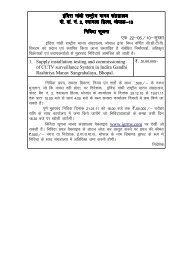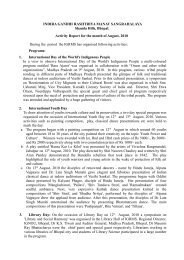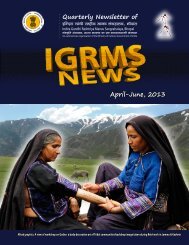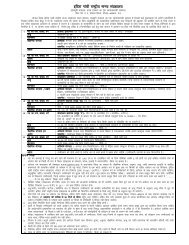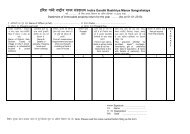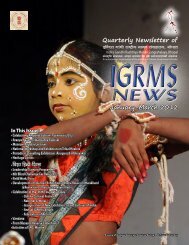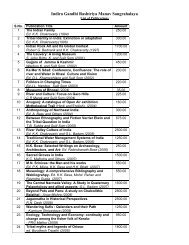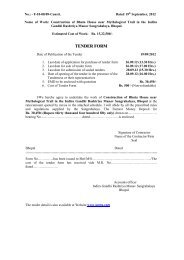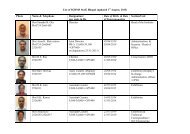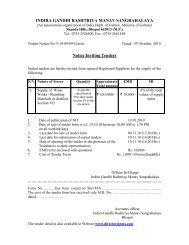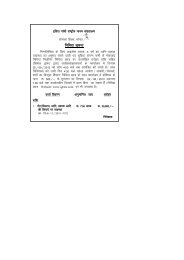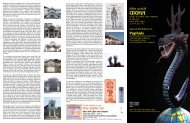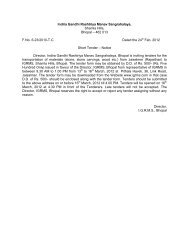Indira Gandhi Rashtriya Manav Sangrahalaya (National ... - IGRMS
Indira Gandhi Rashtriya Manav Sangrahalaya (National ... - IGRMS
Indira Gandhi Rashtriya Manav Sangrahalaya (National ... - IGRMS
You also want an ePaper? Increase the reach of your titles
YUMPU automatically turns print PDFs into web optimized ePapers that Google loves.
288 Multiple Heritage: Role of Specialised Museums in India<br />
and administrative institutions of the Govt. for providing local inputs into the<br />
developmental plans.<br />
Chakravarty’s notes were discussed in the Samiti meeting on 11 th June, 1997.<br />
The members agreed that the objectives of the institution and the scope of its<br />
activities were very much different, and much wider than those of a conventional<br />
Museum. The members of the Samiti felt that the Museum should deepen its<br />
initiatives in revitalizing and presenting the variety and plurality of local knowledge<br />
systems and histories; in demonstrating the simultaneous harmony and diversity<br />
of the Indian languages in creative expression; in stressing the multi-linear process<br />
of bio-cultural evolution, away from the Euro-centric unilinear views; in<br />
dissemination of the knowledge and information among students; in protecting<br />
community rights, and in strengthening involvement of disadvantaged and<br />
vulnerable sections of the society in the Museum programmes.<br />
These resolutions paved the path for a major emphasis in spreading out the<br />
Museum activities which were hitherto confined, more or less, to a configuration<br />
of conventional museum, though not wanted as such. In this regard, the 9 th Five<br />
Year Plan period (1997-2002) was a turning stage in the history of the <strong>IGRMS</strong>.<br />
The ‘Outreach’ activities of the Museum surged out to different corners of the<br />
country. The Government, by recognizing the role of <strong>IGRMS</strong> as a catalytic agent<br />
for revitalizing various life enhancing community traditions, enhanced the financial<br />
allocations of annual budgetary provisions considerably. The Museum established<br />
direct contacts with different segments of folk and tribal communities in different<br />
eco-climatic zones, and organized special thematic exhibitions on environmental<br />
values and life enhancing traditions, and also interactive workshops to promote<br />
the different traditional art forms and traditional knowledge systems of the<br />
communities. The ‘Outreach’ activities of the Museum received further boost<br />
during the 10 th Plan period (2002-07), in terms of increased financial support<br />
from the government, to do more and more interactive community related<br />
programmes. The Museum has continued to follow the twin-strategies of ‘taking<br />
museum to communities and bringing communities to museum’, in order to translate the<br />
new perception into action. Some of the significant achievements under this<br />
programme were as follows.<br />
Taking Museum to the Communities<br />
To spread awareness on the importance of man-environment relations a new<br />
traveling exhibition ‘Sacred Groves of India’ was created for circulation in different<br />
parts of India. This exhibition depicts various methods adopted traditionally by<br />
different communities in conserving bio-diversity. The exhibition travelled from<br />
place to place from time to time. The Museum has simultaneously started intensive<br />
field programmes among various community groups, to document, preserve, and<br />
disseminate their eco-specific knowledge on management of natural resources.<br />
A series of such interactions have generated rich data and artifacts, besides a



